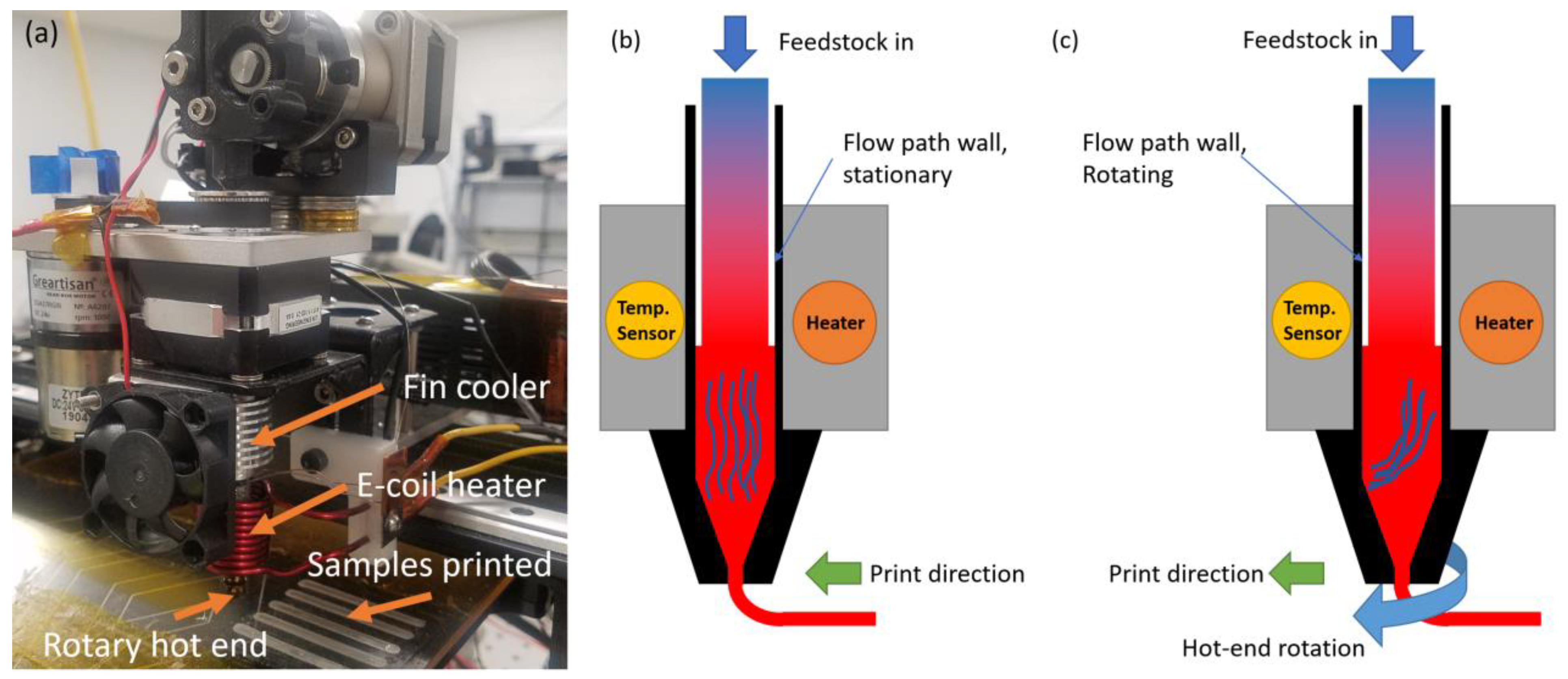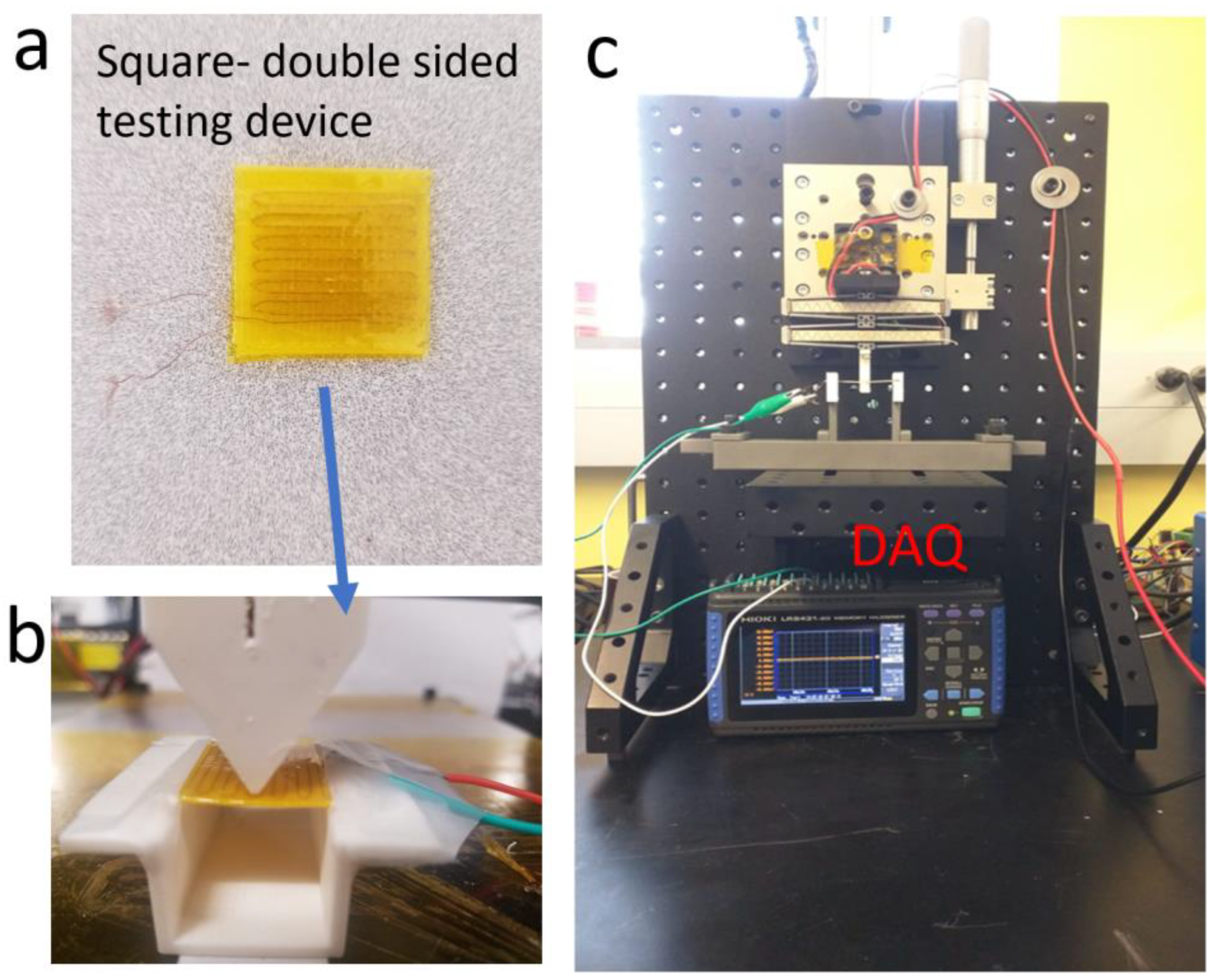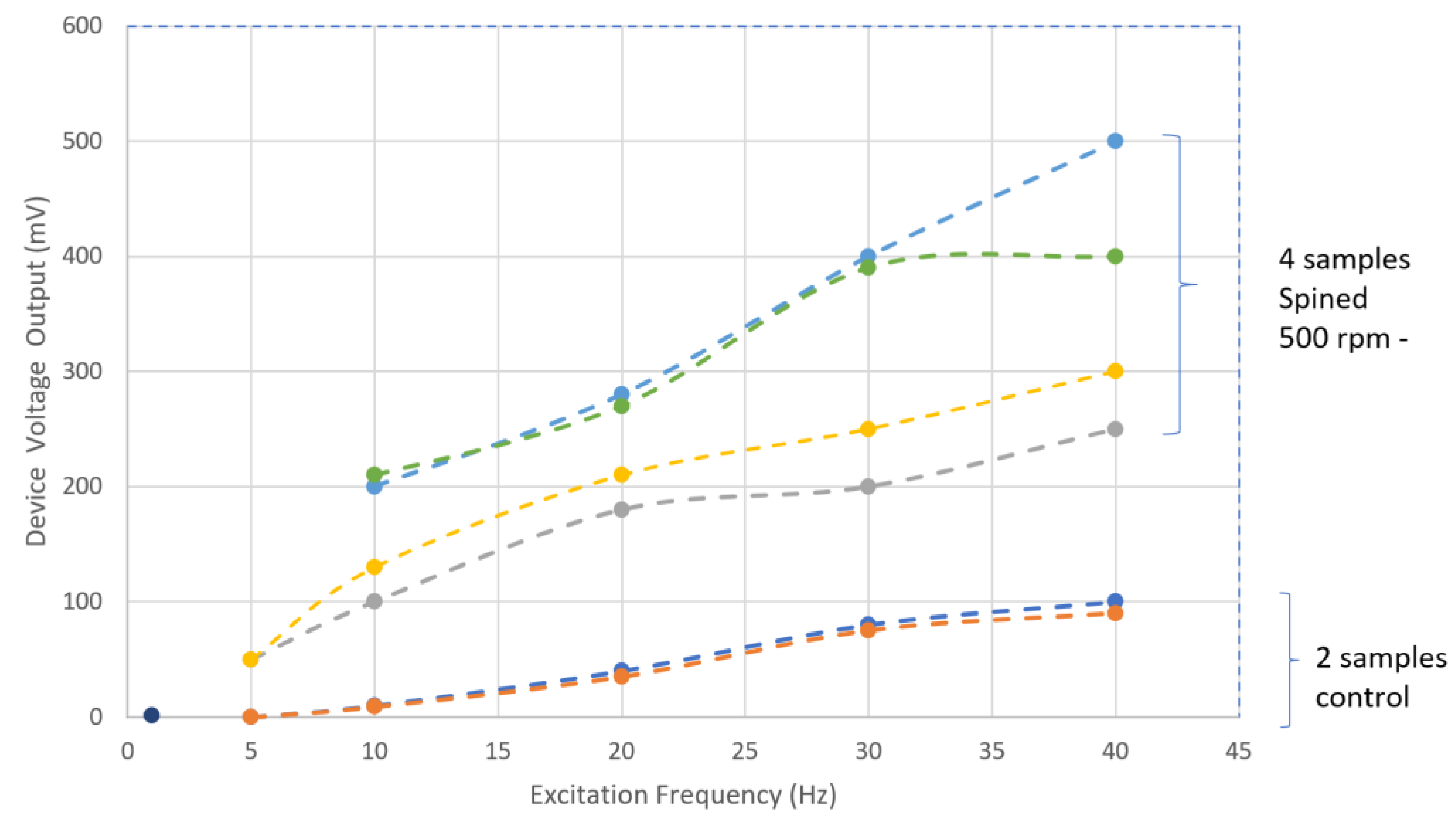Enhancing the Piezoelectric Properties of 3D Printed PVDF Using Concurrent Torsional Shear Strain
Abstract
:Author Contributions
Funding
Data Availability Statement
Conflicts of Interest
References
- Brenken, B.; Barocio, E.; Favaloro, A.; Kunc, V.; Pipes, R.B. Fused Filament Fabrication of Fiber-Reinforced Polymers: A Review. Addit. Manuf. 2018, 21, 1–16. [Google Scholar] [CrossRef]
- Spoerk, M.; Holzer, C.; Gonzalez-Gutierrez, J. Material Extrusion-based Additive Manufacturing of Polypropylene: A Review on How to Improve Dimensional Inaccuracy and Warpage. J. Appl. Polym. Sci. 2020, 137, 48545. [Google Scholar] [CrossRef]
- McIlroy, C.; Olmsted, P.D. Deformation of an Amorphous Polymer during the Fused-Filament-Fabrication Method for Additive Manufacturing. J. Rheol. (N. Y.) 2017, 61, 379–397. [Google Scholar] [CrossRef]
- McIlroy, C.; Olmsted, P.D. Disentanglement Effects on Welding Behaviour of Polymer Melts during the Fused-Filament-Fabrication Method for Additive Manufacturing. Polymer 2017, 123, 376–391. [Google Scholar] [CrossRef]
- Spoerk, M.; Arbeiter, F.; Cajner, H.; Sapkota, J.; Holzer, C. Parametric Optimization of Intra-and Inter-layer Strengths in Parts Produced by Extrusion-based Additive Manufacturing of Poly (Lactic Acid). J. Appl. Polym. Sci. 2017, 134, 45401. [Google Scholar] [CrossRef]
- Aliheidari, N.; Christ, J.; Tripuraneni, R.; Nadimpalli, S.; Ameli, A. Interlayer Adhesion and Fracture Resistance of Polymers Printed through Melt Extrusion Additive Manufacturing Process. Mater. Des. 2018, 156, 351–361. [Google Scholar] [CrossRef]
- Yin, J.; Lu, C.; Fu, J.; Huang, Y.; Zheng, Y. Interfacial Bonding during Multi-Material Fused Deposition Modeling (FDM) Process Due to Inter-Molecular Diffusion. Mater. Des. 2018, 150, 104–112. [Google Scholar] [CrossRef]
- Spoerk, M.; Arbeiter, F.; Raguž, I.; Weingrill, G.; Fischinger, T.; Traxler, G.; Schuschnigg, S.; Cardon, L.; Holzer, C. Polypropylene Filled with Glass Spheres in Extrusion-based Additive Manufacturing: Effect of Filler Size and Printing Chamber Temperature. Macromol. Mater. Eng. 2018, 303, 1800179. [Google Scholar] [CrossRef]
- Rahmatabadi, D.; Aberoumand, M.; Soltanmohammadi, K.; Soleyman, E.; Ghasemi, I.; Baniassadi, M.; Abrinia, K.; Bodaghi, M.; Baghani, M. Toughening PVC with Biocompatible PCL Softeners for Supreme Mechanical Properties, Morphology, Shape Memory Effects, and FFF Printability. Macromol. Mater. Eng. 2023, 308, 2300114. [Google Scholar] [CrossRef]
- Soleyman, E.; Rahmatabadi, D.; Soltanmohammadi, K.; Aberoumand, M.; Ghasemi, I.; Abrinia, K.; Baniassadi, M.; Wang, K.; Baghani, M. Shape Memory Performance of PETG 4D Printed Parts under Compression in Cold, Warm, and Hot Programming. Smart Mater. Struct. 2022, 31, 085002. [Google Scholar] [CrossRef]
- Han, P.; Tofangchi, A.; Zhang, S.; Izquierdo, J.J.; Hsu, K. Interface Healing between Adjacent Tracks in Fused Filament Fabrication Using In-Process Laser Heating. 3d Print. Addit. Manuf. 2023, 10, 808–815. [Google Scholar] [CrossRef] [PubMed]
- Han, P.; Zhang, S.; Tofangchi, A.; Izquierdo, J.; Torabnia, S.; Hsu, K. Development and Implementation of In-Process, Orbiting Laser-Assisted Healing Technique on Fused Filament Fabrication. Int. J. Adv. Manuf. Technol. 2023, 127, 1517–1524. [Google Scholar] [CrossRef]
- Han, P.; Zhang, S.; Yang, Z.; Riyad, M.F.; Popa, D.O.; Hsu, K. In-Process Orbiting Laser-Assisted Technique for the Surface Finish in Material Extrusion-Based 3D Printing. Polymer 2023, 15, 2221. [Google Scholar] [CrossRef] [PubMed]
- Bengfort, P.; Stracke, D.; Künne, B. Establishment of a Rotary Print Head to Effect Residual Stresses and Interlayer Bonding in an FLM-Process. J. Manuf. Mater. Process. 2021, 5, 82. [Google Scholar] [CrossRef]
- Han, P.; Zhang, S.; Tofangchi, A.; Hsu, K. Relaxation of Residual Stress in Fused Filament Fabrication Part with In-Process Laser Heating. Procedia Manuf. 2021, 53, 466–471. [Google Scholar] [CrossRef]
- Puerta, A.P.V.; Fernandez-Vidal, S.R.; Batista, M.; Girot, F. Fused Deposition Modelling Interfacial and Interlayer Bonding in PLA Post-Processed Parts. Rapid Prototyp. J. 2019, 26, 585–592. [Google Scholar] [CrossRef]
- Lluch-Cerezo, J.; Benavente, R.; Meseguer, M.D.; García-Manrique, J.A. Effect of a Powder Mould in the Post-Process Thermal Treatment of ABS Parts Manufactured with FDM Technology. Polymer 2021, 13, 2422. [Google Scholar] [CrossRef]
- Lei, T.; Yu, L.; Zheng, G.; Wang, L.; Wu, D.; Sun, D. Electrospinning-Induced Preferred Dipole Orientation in PVDF Fibers. J. Mater. Sci. 2015, 50, 4342–4347. [Google Scholar] [CrossRef]
- Kalimuldina, G.; Turdakyn, N.; Abay, I.; Medeubayev, A.; Nurpeissova, A.; Adair, D.; Bakenov, Z. A Review of Piezoelectric PVDF Film by Electrospinning and Its Applications. Sensors 2020, 20, 5214. [Google Scholar] [CrossRef]
- Wang, G.; Liu, T.; Sun, X.-C.; Li, P.; Xu, Y.-S.; Hua, J.-G.; Yu, Y.-H.; Li, S.-X.; Dai, Y.-Z.; Song, X.-Y. Flexible Pressure Sensor Based on PVDF Nanofiber. Sens. Actuators A Phys. 2018, 280, 319–325. [Google Scholar] [CrossRef]
- Ramasundaram, S.; Rahaman, A.; Kim, B. Direct Preparation of β-Crystalline Poly (Vinylidene Fluoride) Nanofibers by Electrospinning and the Use of Non-Polar Silver Nanoparticles Coated Poly (Vinylidene Fluoride) Nanofibers as Electrodes for Piezoelectric Sensor. Polymer 2019, 183, 121910. [Google Scholar] [CrossRef]
- Shi, K.; Sun, B.; Huang, X.; Jiang, P. Synergistic Effect of Graphene Nanosheet and BaTiO3 Nanoparticles on Performance Enhancement of Electrospun PVDF Nanofiber Mat for Flexible Piezoelectric Nanogenerators. Nano Energy 2018, 52, 153–162. [Google Scholar] [CrossRef]
- Li, Q.; Xing, J.; Shang, D.; Wang, Y. A Flow Velocity Measurement Method Based on a PVDF Piezoelectric Sensor. Sensors 2019, 19, 1657. [Google Scholar] [CrossRef]
- Hernández-Rivera, D.; Rodríguez-Roldán, G.; Mora-Martínez, R.; Suaste-Gómez, E. A Capacitive Humidity Sensor Based on an Electrospun PVDF/Graphene Membrane. Sensors 2017, 17, 1009. [Google Scholar] [CrossRef]
- Joseph, J.; Kumar, M.; Tripathy, S.; Kumar, G.D.V.S.; Singh, S.G.; Vaniari, S.R.K. A Highly Flexible Tactile Sensor with Self-Poled Electrospun PVDF Nanofiber. In Proceedings of the 2018 IEEE SENSORS, New Delhi, India, 28–31 October 2018; pp. 1–4. [Google Scholar]
- Krishnamoorthy, K.; Pazhamalai, P.; Mariappan, V.K.; Nardekar, S.S.; Sahoo, S.; Kim, S.-J. Probing the Energy Conversion Process in Piezoelectric-Driven Electrochemical Self-Charging Supercapacitor Power Cell Using Piezoelectrochemical Spectroscopy. Nat. Commun. 2020, 11, 2351. [Google Scholar] [CrossRef]
- Yuan, X.; Yan, A.; Lai, Z.; Liu, Z.; Yu, Z.; Li, Z.; Cao, Y.; Dong, S. A Poling-Free PVDF Nanocomposite via Mechanically Directional Stress Field for Self-Powered Pressure Sensor Application. Nano Energy 2022, 98, 107340. [Google Scholar] [CrossRef]
- Hu, B.; Cai, Q.; Xu, R.; Mo, H.; Chen, C.; Zhang, F.; Lei, C. Influence of Uniaxial Cold Stretching Followed by Uniaxial Hot Stretching Conditions on Crystal Transformation and Microstructure in Extrusion Cast and Annealed Polyvinylidene Fluoride Porous Membranes. J. Plast. Film. Sheeting 2015, 31, 269–285. [Google Scholar] [CrossRef]
- Yang, J.; Zhang, Y.; Li, Y.; Wang, Z.; Wang, W.; An, Q.; Tong, W. Piezoelectric Nanogenerators Based on Graphene Oxide/PVDF Electrospun Nanofiber with Enhanced Performances by in-Situ Reduction. Mater. Today Commun. 2021, 26, 101629. [Google Scholar] [CrossRef]
- Song, S.; Zheng, Z.; Bi, Y.; Lv, X.; Sun, S. Improving the Electroactive Phase, Thermal and Dielectric Properties of PVDF/Graphene Oxide Composites by Using Methyl Methacrylate-Co-Glycidyl Methacrylate Copolymers as Compatibilizer. J. Mater. Sci. 2019, 54, 3832–3846. [Google Scholar] [CrossRef]
- Lee, C.; Tarbutton, J.A. Polyvinylidene Fluoride (PVDF) Direct Printing for Sensors and Actuators. Int. J. Adv. Manuf. Technol. 2019, 104, 3155–3162. [Google Scholar] [CrossRef]
- Yang, L.; Cheng, M.; Lyu, W.; Shen, M.; Qiu, J.; Ji, H.; Zhao, Q. Tunable Piezoelectric Performance of Flexible PVDF Based Nanocomposites from MWCNTs/Graphene/MnO2 Three-Dimensional Architectures under Low Poling Electric Fields. Compos. Part. A Appl. Sci. Manuf. 2018, 107, 536–544. [Google Scholar] [CrossRef]
- Ting, Y.; Suprapto; Bunekar, N.; Sivasankar, K.; Aldori, Y.R. Using Annealing Treatment on Fabrication Ionic Liquid-Based PVDF Films. Coatings 2020, 10, 44. [Google Scholar] [CrossRef]
- Choi, M.H.; Yang, S.C. CoFe2O4 Nanofiller Effect on β-Phase Formation of PVDF Matrix for Polymer-Based Magnetoelectric Composites. Mater. Lett. 2018, 223, 73–77. [Google Scholar] [CrossRef]
- Han, P.; Tofangchi, A.; Zhang, S.; Desphande, A.; Hsu, K. Effect of In-Process Laser Interface Heating on Strength Isotropy of Extrusion-Based Additively Manufactured PEEK. Procedia Manuf. 2020, 48, 737–742. [Google Scholar] [CrossRef]
- Kim, H.; Torres, F.; Wu, Y.; Villagran, D.; Lin, Y.; Tseng, T.-L.B. Integrated 3D Printing and Corona Poling Process of PVDF Piezoelectric Films for Pressure Sensor Application. Smart Mater. Struct. 2017, 26, 085027. [Google Scholar] [CrossRef]




Disclaimer/Publisher’s Note: The statements, opinions and data contained in all publications are solely those of the individual author(s) and contributor(s) and not of MDPI and/or the editor(s). MDPI and/or the editor(s) disclaim responsibility for any injury to people or property resulting from any ideas, methods, instructions or products referred to in the content. |
© 2023 by the authors. Licensee MDPI, Basel, Switzerland. This article is an open access article distributed under the terms and conditions of the Creative Commons Attribution (CC BY) license (https://creativecommons.org/licenses/by/4.0/).
Share and Cite
Han, P.; Tofangchi, A.; Carr, D.; Zhang, S.; Hsu, K. Enhancing the Piezoelectric Properties of 3D Printed PVDF Using Concurrent Torsional Shear Strain. Polymers 2023, 15, 4204. https://doi.org/10.3390/polym15214204
Han P, Tofangchi A, Carr D, Zhang S, Hsu K. Enhancing the Piezoelectric Properties of 3D Printed PVDF Using Concurrent Torsional Shear Strain. Polymers. 2023; 15(21):4204. https://doi.org/10.3390/polym15214204
Chicago/Turabian StyleHan, Pu, Alireza Tofangchi, Derek Carr, Sihan Zhang, and Keng Hsu. 2023. "Enhancing the Piezoelectric Properties of 3D Printed PVDF Using Concurrent Torsional Shear Strain" Polymers 15, no. 21: 4204. https://doi.org/10.3390/polym15214204
APA StyleHan, P., Tofangchi, A., Carr, D., Zhang, S., & Hsu, K. (2023). Enhancing the Piezoelectric Properties of 3D Printed PVDF Using Concurrent Torsional Shear Strain. Polymers, 15(21), 4204. https://doi.org/10.3390/polym15214204






